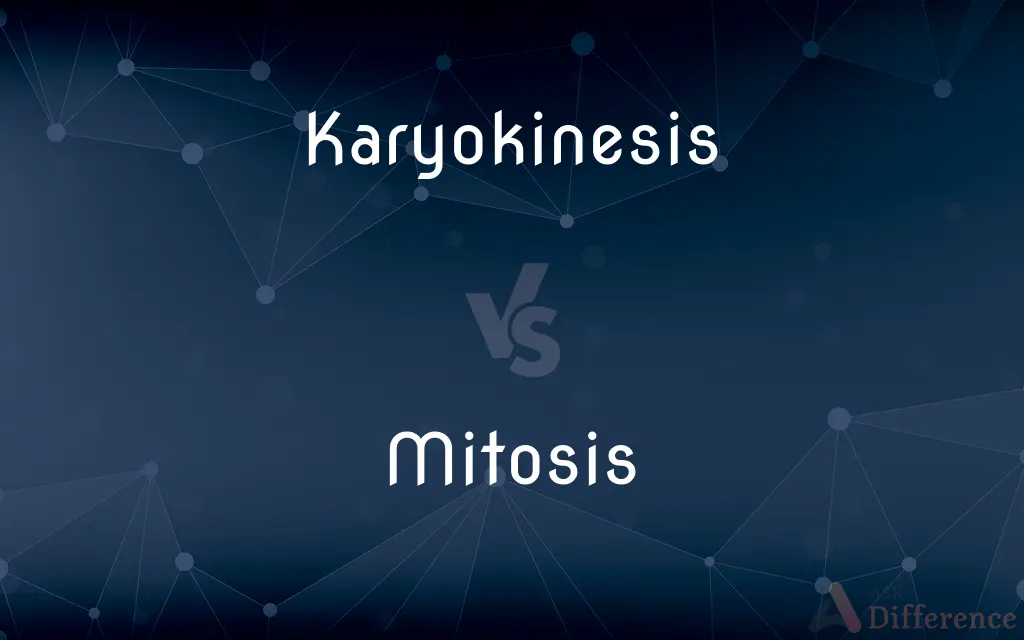Karyokinesis vs. Mitosis — What's the Difference?
Edited by Tayyaba Rehman — By Fiza Rafique — Updated on April 23, 2024
Karyokinesis is the nuclear division process in cells, focusing on chromosomal separation; mitosis encompasses karyokinesis and cytokinesis, resulting in two daughter cells.

Difference Between Karyokinesis and Mitosis
Table of Contents
ADVERTISEMENT
Key Differences
Karyokinesis involves the division of a cell's nucleus and its genetic material, specifically the chromosomes. Mitosis, on the other hand, is a broader term that includes both karyokinesis and cytokinesis, the latter referring to the division of the cell's cytoplasm.
During karyokinesis, chromosomes condense and line up at the cell's equator, preparing to be pulled apart. Whereas in mitosis, this alignment is followed by cytokinesis, which physically splits the cell into two separate cells.
Karyokinesis ensures that each daughter nucleus receives an identical set of chromosomes. Mitosis ensures that each new cell receives not only a complete set of chromosomes but also a sufficient amount of cytoplasm and organelles.
The end result of karyokinesis is two nuclei in one cell, which is still considered a single cell until cytokinesis occurs. In contrast, mitosis concludes with two distinct daughter cells, each fully functional and independent.
The regulation of karyokinesis is critical for genetic stability, focusing solely on the accurate distribution of chromosomes. Mitosis, encompassing the entire cell division process, is crucial for growth, repair, and reproduction in multicellular organisms.
ADVERTISEMENT
Comparison Chart
Definition
Division of the cell nucleus.
Division of the cell nucleus and cytoplasm.
Constituent processes
Only involves the separation of chromosomes.
Includes karyokinesis and cytokinesis.
Result
Two nuclei in one cell.
Two separate daughter cells.
Biological role
Ensures accurate distribution of chromosomes.
Facilitates growth, repair, and reproduction.
Phase of cell cycle
Part of the mitosis phase, specifically prophase to telophase.
Encompasses the entire process from prophase to cytokinesis.
Compare with Definitions
Karyokinesis
A phase within the larger process of cell division.
Karyokinesis precedes cytokinesis during the cell division process.
Mitosis
Encompasses multiple stages including prophase, metaphase, anaphase, and telophase followed by cytokinesis.
Cells in the metaphase of mitosis align their chromosomes at the metaphase plate.
Karyokinesis
Separation process of chromosomes into daughter nuclei.
During karyokinesis, the chromosomes become visible as they condense.
Mitosis
Highly regulated to ensure accurate cell replication.
Checkpoints in mitosis prevent cells with damaged DNA from dividing.
Karyokinesis
Regulated by a complex series of biochemical events.
Various kinases and cyclins regulate the progression of karyokinesis.
Mitosis
Involves both nuclear and cytoplasmic division.
After the nucleus divides in mitosis, cytokinesis divides the cell’s cytoplasm.
Karyokinesis
Division of a cell's nucleus during mitosis or meiosis.
Karyokinesis is crucial for maintaining the number of chromosomes in daughter cells.
Mitosis
A type of cell division that results in two daughter cells each having the same number and kind of chromosomes as the parent nucleus.
Mitosis is essential for tissue growth and repair.
Karyokinesis
Involves the breakdown and reformation of the nuclear envelope.
The nuclear envelope disintegrates during early karyokinesis.
Mitosis
Occurs in somatic cells and is fundamental for reproduction.
Mitosis occurs in human body cells to replace old or damaged cells.
Karyokinesis
Division of a cell nucleus during mitosis.
Mitosis
In cell biology, mitosis () is a part of the cell cycle in which replicated chromosomes are separated into two new nuclei. Cell division gives rise to genetically identical cells in which the total number of chromosomes is maintained.
Karyokinesis
See mitosis.
Mitosis
A type of cell division that results in two daughter cells each having the same number and kind of chromosomes as the parent nucleus, typical of ordinary tissue growth
The single large egg cell subdivides by repeated mitosis
Each mitosis seems to be associated with an increase in calcium
Karyokinesis
(biology) The process of change that takes place during the division of a cell nucleus at mitosis or meiosis.
Mitosis
The process in cell division by which the nucleus divides, typically consisting of four stages, prophase, metaphase, anaphase, and telophase, and normally resulting in two new nuclei, each of which contains a complete copy of the parental chromosomes.Also called karyokinesis.
Karyokinesis
The indirect division of cells in which, prior to division of the cell protoplasm, complicated changes take place in the nucleus, attended with movement of the nuclear fibrils; - opposed to karyostenosis. The nucleus becomes enlarged and convoluted, and finally the threads are separated into two groups which ultimately become disconnected and constitute the daughter nuclei. Called also mitosis. See Cell development, under Cell.
Mitosis
The entire process of cell division including division of the nucleus and the cytoplasm.
Karyokinesis
The changes that occur in the nucleus of a cell, especially movements of the chromosomes, in the process of cell division.
Mitosis
(cytology) The division of a cell nucleus in which the genome is copied and separated into two identical halves. It is normally followed by cell division.
Karyokinesis
Organic process consisting of the division of the nucleus of a cell during mitosis or meiosis
Mitosis
See Karyokinesis.
Mitosis
Cell division in which the nucleus divides into nuclei containing the same number of chromosomes
Common Curiosities
How does mitosis differ from karyokinesis?
Mitosis includes karyokinesis (nuclear division) and cytokinesis (cytoplasmic division), resulting in two daughter cells.
What stages of mitosis involve karyokinesis?
Karyokinesis occurs from prophase to telophase within mitosis.
What is karyokinesis?
Karyokinesis is the process of dividing the cell's nucleus where chromosomes are separated into two sets.
Is cytokinesis part of karyokinesis?
No, cytokinesis is the process that follows karyokinesis in mitosis, involving the division of the cytoplasm.
How are chromosomes handled during karyokinesis?
During karyokinesis, chromosomes are condensed, aligned, and then pulled to opposite sides of the cell.
What are the key differences in chromosome handling between karyokinesis and meiosis?
In karyokinesis, chromosomes are duplicated and equally divided, while in meiosis, chromosome number is halved to produce gametes.
Why is karyokinesis important?
Karyokinesis ensures that each daughter cell receives an exact copy of the genetic material.
Can mitosis occur without cytokinesis?
Yes, in certain cases like in some muscle and fungal cells, mitosis occurs without cytokinesis, leading to multinucleated cells.
What controls the process of karyokinesis?
Karyokinesis is controlled by a complex network of proteins including cyclins and kinases.
What happens if karyokinesis is not properly regulated?
Improper regulation of karyokinesis can lead to genetic disorders or cancer due to the uneven distribution of chromosomes.
Does karyokinesis occur in plant cells?
Yes, karyokinesis occurs in both plant and animal cells as part of cell division.
Are there any diseases associated with faulty mitosis?
Yes, faulty mitosis can lead to diseases such as cancer where cells divide uncontrollably.
How do cells ensure that karyokinesis is accurately completed before cytokinesis begins?
Cells have checkpoints that ensure chromosomes are correctly aligned and separated before cytokinesis commences.
How long does karyokinesis take during mitosis?
The duration of karyokinesis can vary but typically lasts a few minutes in most animal cells.
What is the role of the spindle apparatus in karyokinesis?
The spindle apparatus is crucial for pulling chromosomes to opposite ends of the cell during karyokinesis.
Share Your Discovery

Previous Comparison
Immerge vs. Immerse
Next Comparison
Mop vs. MapAuthor Spotlight
Written by
Fiza RafiqueFiza Rafique is a skilled content writer at AskDifference.com, where she meticulously refines and enhances written pieces. Drawing from her vast editorial expertise, Fiza ensures clarity, accuracy, and precision in every article. Passionate about language, she continually seeks to elevate the quality of content for readers worldwide.
Edited by
Tayyaba RehmanTayyaba Rehman is a distinguished writer, currently serving as a primary contributor to askdifference.com. As a researcher in semantics and etymology, Tayyaba's passion for the complexity of languages and their distinctions has found a perfect home on the platform. Tayyaba delves into the intricacies of language, distinguishing between commonly confused words and phrases, thereby providing clarity for readers worldwide.
















































